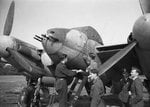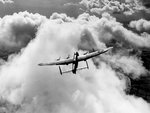wmaxt
Staff Sergeant
Gemhorse said:Awesome pic Lanc !...I've seen another shot of one on one engine at a post-war airshow. They were definately capable of returning damaged on one engine in a slow descent....
As far as the B-26 went, General Ira Eaker was disappointed to receive them instead of B-17's B-24's, which he needed for his Strategic Plan. However, flying at medium heights [12,000 ft max.]- and with a Spitfire escort, they sustained very few losses after their disastrous introduction. As in N.Africa, they decided B-26's were too large and not fast enough for low-level attacks, where surprise was crucial to minimise losses. In the following months, they were transferred to the 9th AF and produced some of the more accurate bombing results in the ETO....
For my money, the B-25 was the consumate US Medium bomber, and it was a shame they didn't give them more powerful engines...They made a huge contribution overall to the War effort, in all their theatres of operations and proved very adaptable and popular...that's probably why they are still quite plentiful in Warbird Aviation today.....
Also, wmaxt, the Mosquito carried 4,000 lbs of bombs, the same as a B-17, which makes it abit more than a 'Light-bomber'....
And LG, you're a scamp with this 'B-29 with two tallboys' thing....As already debated, that happened after the War, and a Lancaster could've also carried a 10,000 lb A-bomb if required...B-29's suffered losses from Jap flak, fighters and airborne phospherous bombs...not to mention all their 'teething-troubles....- I applaud your patriotic fervour, but although the biggest bomber of the War, biggest doesn't necessarily mean best.....In later years, the A-4 Skyhawk proved this and it was also capable of nuclear delivery......
So could the B-25 though it normaly carried 3, the P-38L was rated at 4,000 and could and did carry more on occasion. Carring 4,000 doesn't make it a heavy bomber overall capability in the long range bombing arena does so does the 4 engine layout. The B-17 could carry up tp 17,500 if ammo/fuel was not criticle so I think my mix stands ok.


